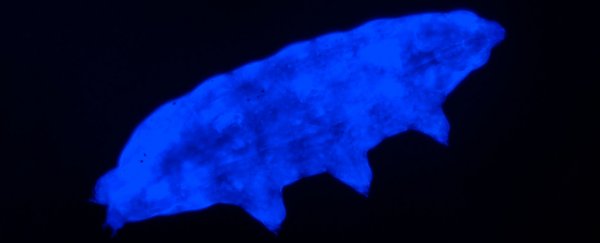The world's most indestructible critter just got even more indestructible.
Not content with its existing abilities to survive extreme temperatures, pressures, and the airless vacuum of space, the humble yet seemingly unkillable tardigrade looks to have unlocked another amazing superpower: the ability to withstand lethal doses of ultraviolet (UV) radiation.
While we have observed tardigrades surviving radiation before now thanks to a 'damage suppression' protein called Dsup, this UV resistance trick is a newly identified feather in the tardigrade's cap, operating via a different kind of biological mechanism.
In a new study, scientists at the Indian Institute of Science detail the discovery of Paramacrobiotus sp. BLR, a strain of the genus Paramacrobiotus, belonging to the class eutardigrada.
Eutardigrades comprise the largest class of tardigrades; they're the chunky-looking ones with reduced lateral appendages (the bits that look like arms and legs).
The team isolated Paramacrobiotus BLR from a moss sample growing on a concrete wall in Bengaluru, India, and in subsequent experiments, subjected the tardigrades to UV radiation emitted from a germicidal lamp, used for sterilisation purposes by killing things like bacteria and viruses.
Under these deadly rays, Paramacrobiotus BLR literally glowed, demonstrating a form of naturally occurring fluorescence called autofluorescence. This kind of fluorescence has been seen before in many animals, including parrots, chameleons, and frogs, although its purpose remains enigmatic.
"Functional significance of this phenomenon is unclear although visual signalling towards potential mates has been attributed in parrots," the researchers, led by first author and biochemist Harikumar R. Suma, explain in their paper.
But Paramacrobiotus BLR did more than just glow under the UV radiation. The majority also tolerated the rays for up to one hour, withstanding damage from the radiation.
A rival species, Hypsibius exemplaris – control tardigrades, if you will – and some neighbouring roundworms (thrown into the mix for good measure) were not so fortunate, however.
According to the researchers, the fluorescence is what actually enables Paramacrobiotus BLR to withstand the radiation. In another experiment, the team extracted the fluorescent aqueous chemical from Paramacrobiotus BLR and covered H. exemplaris in it.
When doused in the glowing extract, H. exemplaris demonstrated increased tolerance than when it wasn't wearing its sunscreen.
"This provides the direct experimental demonstration of photoprotection by fluorescence," the authors conclude.
"The fluorescent compound forms a 'shield' against UV radiation protecting these tardigrades from its lethal effects. We speculate that Paramacrobiotus BLR strain has probably evolved this fluorescence mechanism to counter high UV radiation of tropical southern India (UV index can reach up to 10)."
The findings are reported in Biology Letters.
